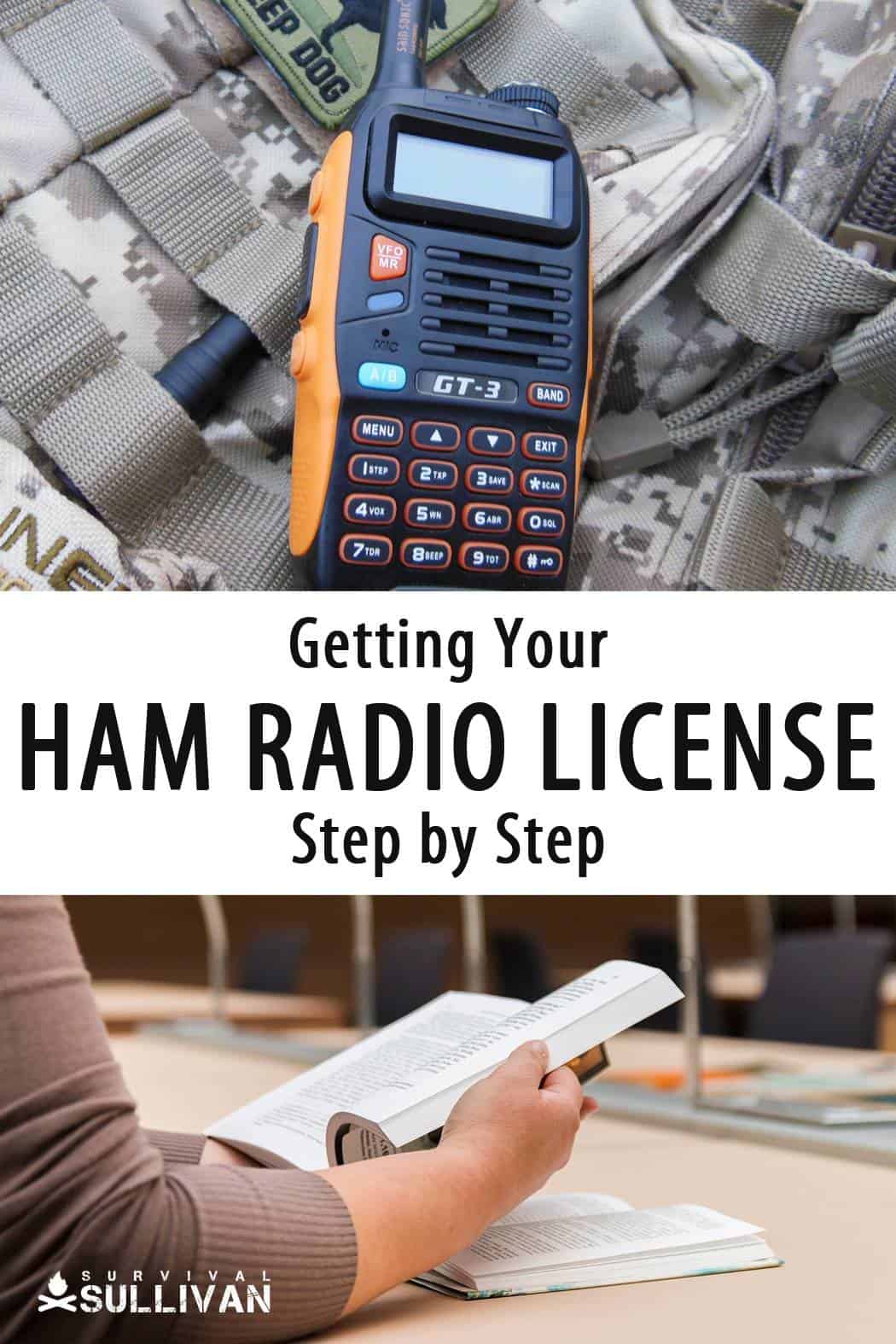Ham radio is a useful resource for your survival toolbox if things go south with the communications network. Cell towers can fail, or in the case of emergencies, could become jammed with usage.

Service could go down during a civil uprising or natural disasters, and you will need a way to communicate with your family, friends, and your survival group.
Unlike other forms of communication, Ham radio requires a license to operate equipment, and there are a few steps you’ll need to take to get yours. There is an exception to this, though.
What Is Ham Radio?
Ham radio, also known as amateur radio, uses radio waves to communicate non-commercial messages and emergency communication.
It is different from CB radio in that it is stronger and can broadcast over a further distance. This makes it better if you are using it for communications in an emergency. CB and Ham also operate over different frequencies.
Why You Need a License
Another difference between Ham and CB is that amateur radio is regulated by the Federal Communications Commission (FCC) under the Communications Act of 1934, and you need to obtain a license to operate a ham radio.
This is because you have access to more frequencies and your power limits are higher than with a CB or FRS (walkie-talkie).
You are also allowed to build your antennas, equipment and modify existing equipment. Because of this, you need to learn the basic electronic principles behind radio waves, dealing with interference and safety issues you may face.
Basic Requirements
The first requirement is a valid US mailing address, you will also need a Taxpayer Identification Number such as your Social Security Number, or an FCC identification number. When you take your exam, you will need a form of photo ID or two alternative forms of identification.
There are three simple steps to getting your Ham license, choosing your level, studying for the exam and finally, taking the exam.
Choose Your Level of License
There are three levels of Licensing for Ham radio; Technician, General, and Amateur Extra.
The Technician license is the entry-level license and where the majority of new Ham operators start. You must pass an exam of 35 questions on radio theory, regulations, and operating practices.
This license gives an operator access to all ham frequencies above 30 megahertz, it allows the use of VHF, UHF, and some higher frequencies.
This license gives you the ability to communicate locally and usually within North America. If you are just interested in talking with local operators, you can stick with this level.
The next level of license is the General License, this is also a 35 question test, after passing you are licensed to communicate worldwide.
You also receive a few more operating privileges than at the Technician license level and can operate on all bands and all modes. You must pass the Technician license exam before you can test for the General license.
This license allows you to talk on short wave radio around the world, and on HF bands. This license would be more useful in emergency situations than the technician license because in an emergency, local bands can get jammed up.
The last level of license is Amateur Extra and is a 50 question exam. Passing it grants the operator all privileges on all bands and modes. You must have passed the previous two levels before passing the Amateur Extra exam.
At this level you have access to all frequencies, including the Advanced and Extra portions of the band. You can administer tests as a volunteer test examiner, and you get a shorter call sign.
Even though the levels are taken in order, you can take them all in the same sitting for one exam fee until you fail one or pass all three exams.
Study For Your Exam
The Amateur Radio Relay League has a website (AARL) with a database where you can search for classes in your area. There are also multiple online classes available.
There are a few different apps and websites you can use to take practice exams:
- Ham Test Prep (Android, iOS)
- Ham Radio Exam (Android, iOS)
- https://hamradioprep.com/
- https://hamstudy.org/
Disclosure: This post has links to 3rd party websites, so I may get a commission if you buy through those links. Survival Sullivan is a participant in the Amazon Services LLC Associates Program. As an Amazon Associate, I earn from qualifying purchases. See my full disclosure for more.
If you prefer books for studying, there are also some great guides to help you prepare. Some of them only cover the first level, and some are for all three levels:
- The ARRL Ham Radio License Manual
- The Ham Radio Study Guide
- Ham Radio License Manual: 30 Ham Radio Practice Tests
- The No Nonsense Technician Class Study Guide
- Cracking the Technician License Exam
Take Your Exam
You can take your exam in person or online, whichever you choose. Your local Ham radio club will usually offer exam dates. ARRL exam search page will help you search for an exam near you.
If you take your exam in person you will need to bring one legal form of photo ID; if you don’t have one, you will need to bring two alternative forms of identification. They can include a birth certificate, social security card, utility bill, or school ID.
You will also need a Federal Registration Number, two #2 pencils, a pen, a calculator, and a form of payment to cover the test fee. The exam fee is $15 for each level, and the volunteer exam team that provides the exam for you is allowed to charge up to $7 in reimbursement fees.
You can ask beforehand what the fees are so you come prepared. Your Ham license is good for 10 years after issue, you can renew it online through the Universal Licensing System from 90 days before the expiration date.
If you happen to let your license expire, you have a two year grace period during which you can still file for renewal but you may not operate your Ham radio after your license expires until you renew it.
After the two year grace period, if your license is still not renewed, the FCC will cancel your license, you will lose your call sign and you will need to retest.
If you choose to take the exam online, you can find options on the ARRL website. Online tests are video supervised and each volunteer team may have different requirements, so you will need to read over the requirements to ensure you have the proper equipment to take the exam online.
With preparation, the General technician exam is not hard to pass, it is a multiple choice test, and roughly 85-90% of examiners pass.
Start Using Your Radio
After you pass your test, the examiners will give you your Certificate of Successful Completion of Examination (CSCE). This is not your license; you still need to be issued your call sign by the FCC before you are legally able to broadcast.
Your official license with call sign will be emailed to you in a PDF format that you can print out, but you can legally start transmitting with other operators as soon as your name and call sign appear in the database, this usually takes about two weeks.
You can then start chatting with fellow technicians on the airwaves. There are even Ham radio conventions around the country that you can attend to purchase equipment and meet other enthusiasts.
With these simple steps you can be licensed to operate a Ham radio, and be assured that if communications fail for a day or a year, you will be prepared.


My dad was military. My grandfather was a cop. They served their country well. But I don’t like taking orders. I’m taking matters into my own hands so I’m not just preparing, I’m going to a friggin’ war to provide you the best of the best survival and preparedness content out there.

Great article.
I teach the HAM Licensing Exam locally and with the internet resources, we have an exceptionally low fail rate.
The exam consists of basic electronic questions and regulation questions. It is not difficult for those who study.
Of the 35 questions on the Technician License, you may miss 9 questions and still pass. The 35 questions come from a pool of the exact questions with the answers which can be studied for passing.
Your license will be good for ten years
If you have access to a HAM Radio during an emergency situation, you do not need a license to transmit. You do not need a license to listen in on conversations to learn procedures and codes.
Handheld radios are available for $55 to $100-plus. 5 watt, 8watt and 10 watt power (the higher the wattage, the greater the transmit distance).
GOOD LUCK!
Are there still amateur radio clubs around in Canada and USA? I used to belong but lost track when they moved from their first location and I would so like to get back into this. Any help would be greatly appreciated.